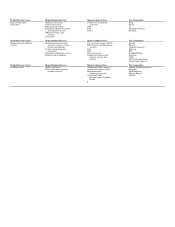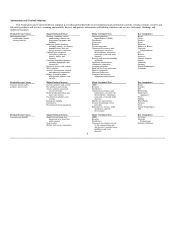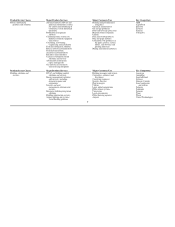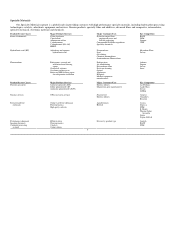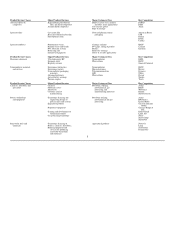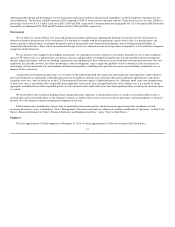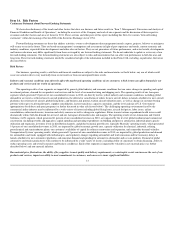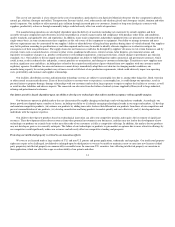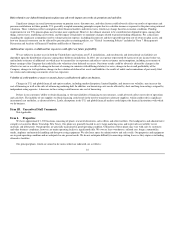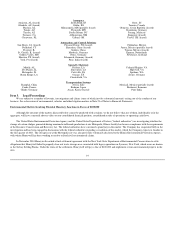Honeywell 2010 Annual Report Download - page 17
Download and view the complete annual report
Please find page 17 of the 2010 Honeywell annual report below. You can navigate through the pages in the report by either clicking on the pages listed below, or by using the keyword search tool below to find specific information within the annual report.
The cost of raw materials is a key element in the cost of our products, particularly in our Specialty Materials (benzene (the key component in phenol),
natural gas, ethylene, fluorspar and sulfur), Transportation Systems (nickel, steel, other metals and ethylene glycol) and Aerospace (nickel, titanium and other
metals) segments. Our inability to offset material price inflation through increased prices to customers, formula or long-term fixed price contracts with
suppliers, productivity actions or through commodity hedges could adversely affect our results of operations.
Our manufacturing operations are also highly dependent upon the delivery of materials (including raw materials) by outside suppliers and their
assembly of major components and subsystems used in our products in a timely manner and in full compliance with purchase order terms and conditions,
quality standards, and applicable laws and regulations. In addition, many major components and product equipment items are procured or subcontracted on a
single-source basis; in some circumstances these suppliers are the sole source of the component or equipment. Our ability to manage inventory and meet
delivery requirements may be constrained by our suppliers' ability to adjust delivery of long-lead time products during times of volatile demand. Our suppliers
may fail to perform according to specifications as and when required and we may be unable to identify alternate suppliers or to otherwise mitigate the
consequences of their non-performance. The supply chains for our businesses could also be disrupted by suppliers' decisions to exit certain businesses and by
external events such as natural disasters, extreme weather events, pandemic health issues, terrorist actions, labor disputes, governmental actions and
legislative or regulatory changes (e.g., product certification or stewardship requirements, sourcing restrictions, climate change or greenhouse gas emission
standards, etc.). Our inability to fill our supply needs would jeopardize our ability to fulfill obligations under commercial and government contracts, which
could, in turn, result in reduced sales and profits, contract penalties or terminations, and damage to customer relationships. Transitions to new suppliers may
result in significant costs and delays, including those related to the required recertification of parts obtained from new suppliers with our customers and/or
regulatory agencies. In addition, because our businesses cannot always immediately adapt their cost structure to changing market conditions, our
manufacturing capacity for certain products may at times exceed or fall short of our production requirements, which could adversely impact our operating
costs, profitability and customer and supplier relationships.
Our facilities, distribution systems and information technology systems are subject to catastrophic loss due to, among other things fire, flood, terrorism
or other natural or man-made disasters. If any of these facilities or systems were to experience a catastrophic loss, it could disrupt our operations, result in
personal injury or property damage, damage relationships with our customers and result in large expenses to repair or replace the facilities or systems, as well
as result in other liabilities and adverse impacts. The same risk can also arise from the failure of critical systems supplied by Honeywell to large industrial,
refining and petrochemical customers.
Our future growth is largely dependent upon our ability to develop new technologies that achieve market acceptance with acceptable margins.
Our businesses operate in global markets that are characterized by rapidly changing technologies and evolving industry standards. Accordingly, our
future growth rate depends upon a number of factors, including our ability to (i) identify emerging technological trends in our target end-markets, (ii) develop
and maintain competitive products, (iii) enhance our products by adding innovative features that differentiate our products from those of our competitors and
prevent commoditization of our products, (iv) develop, manufacture and bring products to market quickly and cost-effectively, and (v) develop and retain
individuals with the requisite expertise.
Our ability to develop new products based on technological innovation can affect our competitive position and requires the investment of significant
resources. These development efforts divert resources from other potential investments in our businesses, and they may not lead to the development of new
technologies or products on a timely basis or that meet the needs of our customers as fully as competitive offerings. In addition, the markets for our products
may not develop or grow as we currently anticipate. The failure of our technologies or products to gain market acceptance due to more attractive offerings by
our competitors could significantly reduce our revenues and adversely affect our competitive standing and prospects.
Protecting our intellectual property is critical to our innovation efforts.
We own or are licensed under a large number of U.S. and non-U.S. patents and patent applications, trademarks and copyrights. Our intellectual property
rights may expire or be challenged, invalidated or infringed upon by third parties or we may be unable to maintain, renew or enter into new licenses of third
party proprietary intellectual property on commercially reasonable terms. In some non-U.S. countries, laws affecting intellectual property are uncertain in
their application, which can affect the scope or enforceability of our patents and other
14


